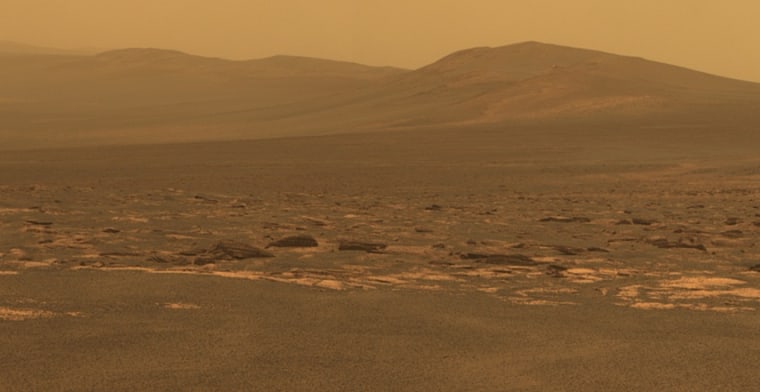NASA's Opportunity rover has reached the rim of a 14-mile-wide crater after nearly three years of traveling across desolate Martian plains, scientists reported Wednesday.
The six-wheeled, golf-cart-sized robot signaled mission managers on Tuesday that it arrived at a location called Spirit Point on Endeavour Crater's rim, NASA's Jet Propulsion Laboratory reported in a mission update.
Scientists selected Endeavour as Opportunity's grandest destination in 2008, after the rover investigated a far smaller target known as Victoria Crater. They say Endeavour should provide an unparalleled opportunity to track the geological history of the Red Planet.
Craters are carved by asteroids or comets impacting into the Martian surface and exposing geological layers from different points in history. Endeavour is the fourth crater that Opportunity will explore, and offers the oldest deposits yet. The studies ahead are expected to provide further clues to Mars' warmer and wetter past.
NASA's Mars Reconnaissance Orbiter has already seen signs that clay minerals are present within Endeavour.
"We're soon going to get the opportunity to sample a rock type the rovers haven't seen yet," JPL's Matthew Golombek, a rover science team member, said in Wednesday's update. "Clay minerals form in wet conditions, so we may learn about a potentially habitable environment that appears to have been very different from those responsible for the rocks comprising the plains."
Last rover standing
The name Spirit Point informally commemorates Opportunity's twin rover, which stopped communicating in March 2010 after getting stuck in loose sand. Mission managers believe the solar-powered rover gave up the ghost due to its inability to generate enough electricity to keep itself going. Spirit's mission officially concluded in May.
"Our arrival at this destination is a reminder that these rovers have continued far beyond the original three-month mission," said John Callas, Mars Exploration Rover project manager at JPL.
This week's milestone brings a renewed sense of adventure to a mission that wowed the public with color portraits of the landscape and the unmistakable geologic discoveries of a warm and wetter past.
For more than a year, the only pictures coming back from the Martian surface have shown Meridiani Planum, the rocky, dune-swept plain that Opportunity has been traversing. Endeavour is about seven miles away from Victoria, but the rover had to take a circuitous 13-mile route to avoid obstacles. It also had to drive backward to keep its right front wheel from wearing out.
Opportunity will spend several months imaging the rim and interior, which has been partially filled in by rocks and sediments. There are no plans to drive across the crater for fear of getting stuck, Callas said. Instead, it will traverse south along the rim.
"We will likely spend years at this location," Callas said. "What a destination! It's not just one spot. There's kilometers of interesting geology to explore."
Extraterrestrial overachievers
The NASA rovers parachuted to opposite sides of Mars in 2004 for what was a planned three-month mission, but both robots operated far beyond their factory warranty. Opportunity has logged more than 20 miles since its landing.
The original twin-rover mission cost $800 million, but the cost and personnel requirements have come down dramatically over the past seven years. Callas estimates that the cost of Opportunity-only operations is $12 million per year.
NASA's next Mars-bound spacecraft is the $2.5 billion Mars Science Laboratory, also known as the Curiosity rover. That car-sized, nuclear-powered robot is due for launch in late November.
In a statement, NASA Administrator Charles Bolden said the current and future missions to Mars demonstrate that "NASA is continuing to write remarkable chapters in our nation's story of exploration."
"Opportunity's findings and data from the upcoming Mars Science Laboratory will play a key role in making possible future human missions to Mars and other places where humans have not yet been," Bolden said.
This report includes information from The Associated Press and msnbc.com.
